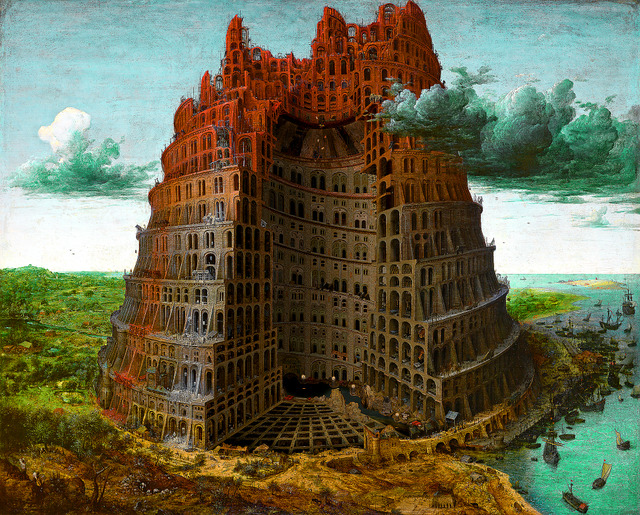via Boing Boing by Mark Frauenfelder

Turing Tumble is a mechanical computer with switches that are activated by rolling marbles down an inclined plane. To program it, you attach plastic switches and components to it. The Kickstarter launched today and it's off to a great start.
Continue reading
=============================
Ramesses II, victor of Kadesh: a kindred spirit of Trump?
via the Guardian by Alex Loktionov

Papyrus Sallier III (col. 11), BM10181,11, which contains a poem praising Ramesses II at the Battle of Kadesh. Photograph: ©Trustees of the British Museum
In 1274BCE, near the Levantine town of Kadesh, a miracle occurred: Ramesses II of Egypt, isolated from his forces due to faulty intelligence, single-handedly destroyed a Hittite army. Out of the 2,500 chariots attacking him, not one survived. The pharaoh subsequently threw countless enemies into the river Orontes, only sparing the Hittite king after he begged for mercy. It was a mighty victory – and a mighty mix of fact and fiction.
Continue reading
=============================
Punishing Peccadilloes? Illicit sex at the early Stuart courts
via OUP Blog by Johanna Luthman

16:58 Hampton Court Palace by brian gillman. CC BY 3.0 via Wikimedia Commons.
At the Tudor and early Stuart royal courts, the careers of influential politicians and courtiers often depended on the preferences of the monarchs: being in the king’s good graces often mattered as much or more for advancements than ability and training. The personality and quirks of the rulers affected many aspects of a courtier’s life, including what today might be considered the most private: their sex lives. When King James I died in 1625, ambitious persons jostling for positions in the formation of Charles’s court would soon learn that the son had different tastes from the father, and expected different behaviors from those around him. While James mostly ignored or tacitly accepted the philandering of his courtiers as long as they kept up a modicum of discretion, Charles was not so forgiving. Under his reign, courtiers soon learned that they had to “keep their virginities,” or “at least lose them not avowedly,” as one courtier wryly remarked. If Charles found out, offenders could face serious consequences.
Continue reading
=============================
How much would a star destroyer cost?
via Boing Boing by Andrea James
 Generation Tech has done a few fun videos estimating the costs of items in the Star Wars universe. In the latest installment, they calculate the cost of a star destroyer.
Generation Tech has done a few fun videos estimating the costs of items in the Star Wars universe. In the latest installment, they calculate the cost of a star destroyer.Continue reading and find out for yourself
=============================
A purple pursuit
via The National Archives blog by Isabella Whitworth
In 2008, friends invited me to look at a collection of family documents relating to dye manufacture in 19th and 20th century Leeds. As a professional artist and tutor working with textiles I had considerable practical experience using natural dyes and was interested in their individual histories, but had never taken it further. An invitation to view an archive changed the course of my life.
Continue reading it is a fascinating story.
=============================
Bosch & Bruegel: From Enemy Painting to Everyday Life
via 3 Quarks Daily: Tim Smith-Laing at Literary Review
They might seem an incongruous pair at first, but historically speaking Hieronymus Bosch and Pieter Bruegel the Elder are a natural duo for comparative study. When Bruegel entered the painters’ guild of Antwerp in 1551, Bosch, who had died in 1516, was still the most famous and imitated artist of the age. Antwerp, the centre of European art production at the time, was home to a whole mini-industry of Bosch imitation and forgery, and Bruegel himself cashed in on the continuing demand for his predecessor’s characteristic style. Look at the Boschian pastiches of his ‘Seven Deadly Sins’ series (1558) or 1557’s Big Fish Eat Little Fish, printed with the misleading inscription ‘Hieronymus Bos inventor’, and you can see why a contemporary dubbed Bruegel a ‘second Hieronymus’.
Continue reading
=============================
Painting reveals interior of Bruegel's Tower of Babel
via Boing Boing by Rob Beschizza

Artist and animator Katsuhiro Otomo of Akira fame, with collage artist Kōsuke Kawamura, painted this view of the inside of the Tower of Babel, a perfectly fascinating pastiche of Bruegel's original.
Continue reading to compare this to the original
=============================
What Explains the Bursts of Innovation in the Archaeological Record?
via Big Think by Stephen Johnson
When paleontologists looked closely at the archaeological record from the transition from the Middle to Upper Paleolithic, they noticed it was punctuated by brief periods during which many new tools, art, and technologies suddenly appeared on the scene. They’ve tended to think these “bursts” of innovation were caused by changes in climate or biology. A new paper, however, suggests sudden innovations were triggered mainly by population growth and migration – a theory that might also explain why some cultures actually lost technologies, like how the Tasmanians mysteriously forgot how to fish.
Continue reading
=============================
A French Philosopher Considers the Kids
via Arts & Letters Daily: Malcolm Harris in New Republic

French philosopher Alain Badiou is, by his own admission, a strange voice to be addressing the youth. “Let’s start with the realities:” he begins his new pamphlet The True Life, “I am 79 years old.” Badiou is also a Maoist of May ’68 vintage, an ontologist who uses set theory, and an advocate for a resurrection of “communism.” Now, skateboard over his shoulder, he has a message for the kids. And some of it is pretty good.
Continue reading
=============================
Some Very Curious Maps of London
via Big Think by Frank Jacobs
As humans migrate to cities, the list of megacities that dot the globe grows longer each year. But London is a special kind of metropolis. Not as old as Rome, nor as big as Beijing, it can still claim to be the true capital of the world – it has the right configuration of history, charm and global appeal.
No wonder a place like London generates a metric ton of guidebooks every year. - to the frustration of londonists everywhere, because most of these mostly repeat the same old highlights.
Curiocity does not fall into that trap. It leaves the tired tropes to those other guides, and provides London with the trivia-rich compendium that befits the British capital so well.
Continue reading
No comments:
Post a Comment